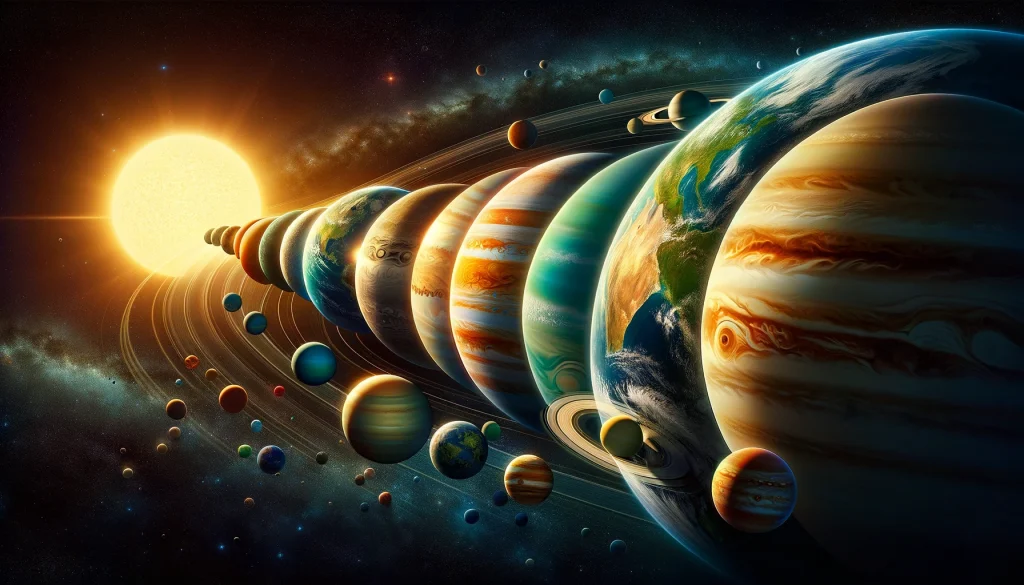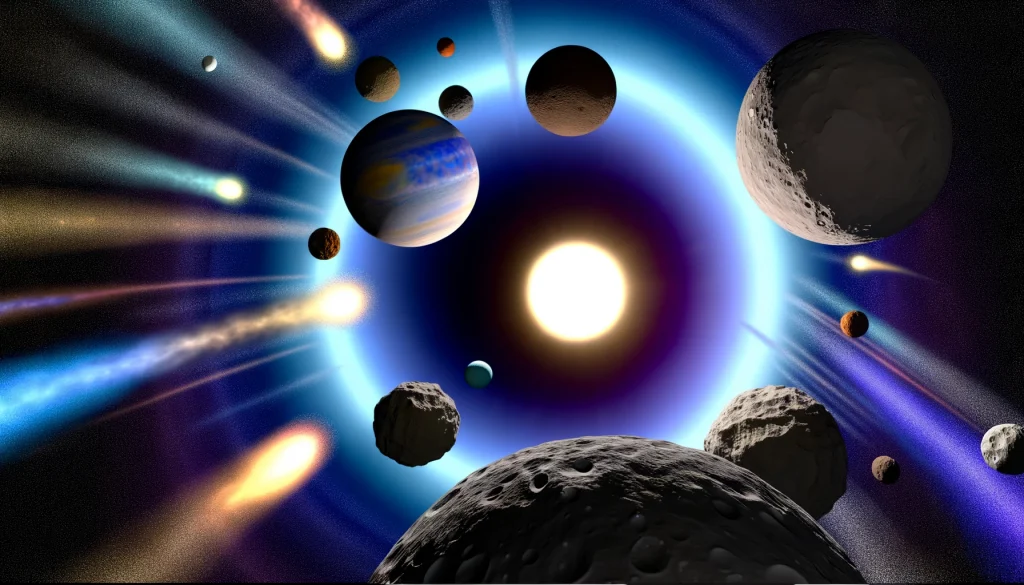Looking up at the night sky, we often marvel at the twinkling points of light. These aren’t just random stars; they might be our celestial neighbors within a vast and fascinating system – our very own solar system.
A tiny speck in the grand scheme of the universe, our solar system is a captivating dance of celestial bodies, each playing a vital role in this cosmic choreography.
Composed of our central star, the Sun, eight planets, numerous dwarf planets, moons, asteroids, and comets, the solar system is a dynamic and ever-evolving neighborhood waiting to be explored.
Our Sun
The Sun reigns supreme at the center of our solar system, acting as the conductor in this cosmic orchestra. It’s the source of life-giving light and energy for all the other celestial bodies that dance around it. But unlike a simple ball of fire, the Sun is a complex and fascinating star.

A Fiery Furnace: Imagine a giant ball of hot plasma, a state of matter where electrons are ripped away from atoms. That’s the Sun in its essence. Through a process called nuclear fusion, hydrogen atoms in the Sun’s core fuse to form helium, releasing tremendous amounts of energy that radiate outwards, reaching every corner of the solar system.
Layers of Majesty: The Sun isn’t a uniform sphere. It has distinct layers, each playing a crucial role:
- Core: The heart of the Sun, where immense pressure and temperature fuel the nuclear fusion process.
- Radiative Zone: Energy from the core travels outwards through this layer, carried by countless photons bouncing off particles.
- Convection Zone: This turbulent zone features hot plasma rising, cooling at the surface, and then sinking back down, creating a churning motion.
- Photosphere: The Sun’s visible surface, where the churning convection zone meets the emptiness of space. This is the layer we see when we gaze directly at the Sun (with proper protection, of course!).
- Chromosphere: A thin layer above the photosphere, visible during solar eclipses, with a reddish hue due to the presence of hydrogen gas.
- Corona: The Sun’s outermost layer, extending millions of kilometers into space. It’s extremely hot and tenuous, visible during a solar eclipse as a faint white halo.
Shaping the Solar System: The Sun’s influence extends far beyond its fiery surface. It constantly emits a stream of charged particles called the solar wind, shaping the environment of the entire solar system. This wind can influence planetary atmospheres, create auroras, and even disrupt communication technologies on Earth. The Sun’s gravity also plays a crucial role, dictating the orbits of planets, moons, and other celestial bodies.
The Planets
Our solar system boasts a fascinating family of eight planets, each with its own unique personality. These celestial bodies can be broadly categorized into two groups: the terrestrial planets and the gas giants.

The Rocky Insiders: Terrestrial Planets
- Mercury: The closest planet to the Sun, Mercury is a tiny world scorched by solar heat. Its rocky surface is covered in craters, a testament to its bombardment by asteroids and comets. Unlike other terrestrial planets, Mercury lacks a significant atmosphere.
- Venus: Earth’s closest neighbor, Venus is shrouded in a thick atmosphere of carbon dioxide, creating a scorching greenhouse effect. Despite its similar size to Earth, Venus boasts volcanic landscapes and an extremely dense atmosphere, making its surface uninhabitable as we know it.
- Earth: Our home planet, Earth stands out as the only known planet to harbor life. With a thin atmosphere composed mainly of nitrogen and oxygen, liquid water oceans, and a diverse range of climates, Earth provides the perfect conditions for life to thrive.
- Mars: Often referred to as the “Red Planet” due to the iron oxide on its surface, Mars is a cold and dry world with a thin atmosphere. However, evidence suggests the presence of ancient water and ongoing geological activity, making Mars a prime target in the search for extraterrestrial life.
These terrestrial planets share some key characteristics: they are relatively small and dense compared to the gas giants, composed primarily of rock and metal, and have (or once had) solid surfaces.
The Gaseous Giants: Dominating the Outer Solar System
Beyond the rocky realm lies the domain of the gas giants. These magnificent planets dwarf the terrestrial planets in size and mass.
- Jupiter: The undisputed king of the planets, Jupiter is a massive ball of gas and swirling storms. It boasts a complex atmosphere with its iconic Great Red Spot, a giant anticyclonic storm raging for centuries. Jupiter also has a vast system of moons, including the volcanic moon Io and the icy moon Europa.
- Saturn: Known for its breathtaking rings composed of dust and ice particles, Saturn is another gas giant with a thick atmosphere and a multitude of moons. Titan, Saturn’s largest moon, even possesses a substantial atmosphere and liquid methane lakes on its surface.
- Uranus and Neptune: These distant giants, often referred to as “ice giants,” have a unique composition that includes elements heavier than hydrogen and helium. Both Uranus and Neptune boast tilted axes, giving them a distinct sideways spin. Uranus is also famous for its ring system, which is tilted nearly perpendicular to its orbit.
The gas giants are predominantly composed of hydrogen and helium, with a smaller fraction of heavier elements. These massive planets also often sport impressive ring systems, adding to their majestic appearance.
Beyond the Planets
Our solar system isn’t just a collection of eight planets. There’s a whole range of fascinating smaller bodies waiting to be explored.

Dwarf Planets: Not Quite Planets, But Still Important
Pluto, once considered the ninth planet, now belongs to a category called dwarf planets. These celestial bodies share some characteristics with planets, but they don’t meet all the criteria. For example, they may not have cleared the neighborhood around their orbit or may be in a region dominated by another object like a star. Eris, another dwarf planet, resides far beyond Pluto in the Kuiper Belt. Dwarf planets come in various sizes and compositions, offering valuable insights into the formation of our solar system.
Asteroids: Rocky Remnants of the Past
The asteroid belt, located between Mars and Jupiter, is a leftover treasure trove from the solar system’s formation. These rocky bodies are remnants of the early solar system that never quite coalesced into planets. Asteroids come in all shapes and sizes, and some even have their own moons! While most asteroids pose no threat, some have orbits that could potentially intersect Earth’s path, making them a subject of ongoing monitoring and potential hazard mitigation strategies.
Comets: Icy Wanderers with Dazzling Tails
Hailing from the fringes of our solar system, comets are like giant dirty snowballs. These icy bodies are composed mostly of frozen gases, water ice, and dust. When a comet ventures closer to the Sun, the Sun’s heat vaporizes some of the ice, creating a glowing head (coma) and a spectacular tail of gas and dust particles streaming away from the Sun. These tails can be millions of kilometers long, making comets some of the most visually stunning objects in the solar system. While most comets pose no danger, their unpredictable paths and occasional close encounters with Earth warrant scientific observation.
Exploring the Solar System
Our understanding of the solar system has come a long way, but there’s still so much to discover. Space exploration plays a critical role in unraveling the mysteries of our cosmic neighborhood. By sending robotic probes, orbiters, and landers to different celestial bodies, we can gather invaluable data about their composition, atmospheres, geology, and potential for harboring life.
Missions Unveiling Hidden Worlds:
- Mercury: The MESSENGER mission mapped Mercury’s surface, revealing a cratered world with volcanic features.
- Venus: Missions like Magellan have peered through the thick Venusian atmosphere, providing insights into its volcanic activity and surface features.
- Mars: This red planet has been a hotbed of exploration, with rovers like Curiosity and Perseverance studying its geology, searching for biosignatures (potential signs of past or present life), and even collecting rock samples for future return to Earth.
- The Gas Giants: Missions like Galileo revolutionized our understanding of Jupiter and its moons, while Cassini’s exploration of Saturn unveiled the wonders of its rings and moon Titan’s intriguing atmosphere. Juno is currently providing new insights into Jupiter’s atmosphere.
- The Outer Reaches: Voyager 1 and 2 ventured beyond the planets, providing us with the first close-up views of the distant gas giants Uranus and Neptune, as well as the wonders of the Kuiper Belt. New Horizons’ historic flyby of Pluto in 2015 revealed a surprisingly complex and dynamic world.
These are just a few examples of the ongoing missions that are pushing the boundaries of our knowledge. As technology advances, future missions promise to delve even deeper, exploring the icy moons of Jupiter and Saturn, searching for potential life on Mars and beyond, and unraveling the secrets of the vast Kuiper Belt and the Oort Cloud, a reservoir of icy objects at the solar system’s fringes.
Unveiling the Wonders: A Solar System Full of Surprises
Our solar system, a captivating dance of celestial bodies, is much more than just eight planets orbiting a star. At its center lies the Sun, a giant ball of hot plasma, radiating life-giving energy throughout the system. The eight planets themselves come in two distinct flavors: the rocky terrestrial planets closer to the Sun, and the majestic gas giants residing in the outer realms. Beyond these giants, a realm of smaller bodies like dwarf planets, asteroids, and comets paint a picture of the solar system’s dynamic past and ongoing evolution.
Space exploration has been instrumental in peeling back the layers of mystery surrounding these celestial bodies. Missions like MESSENGER, Magellan, Curiosity, Cassini, and the Voyager probes have unveiled volcanic landscapes on Venus, searched for signs of life on Mars, revealed the wonders of Saturn’s rings, and provided us with the first close-up views of distant worlds like Pluto.
The journey of exploration continues. Future missions promise to delve deeper into the icy moons of Jupiter and Saturn, search for potential life in hidden oceans or on exoplanets orbiting distant stars, and unravel the secrets of the vast Kuiper Belt and the Oort Cloud. As we venture further and gather more data, our understanding of the solar system is constantly evolving. New discoveries might reshape our perspective on these celestial neighbors, offering even more compelling evidence of the wonders and potential for life that lie within our own cosmic neighborhood.
